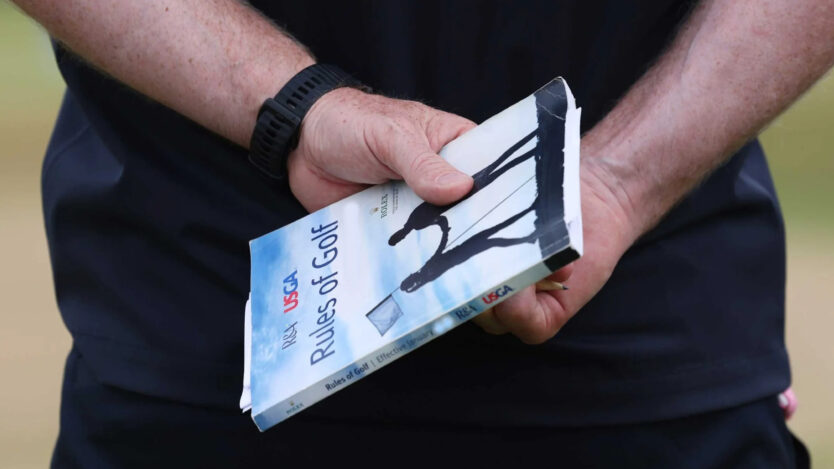Administrating or playing in the first competition of the year? Here is a quintet of the updates from the 2023 Rules of Golf that could have an impact our games…
This article is part of GCMA Insights – topical content for golf industry professionals, discussing the things that matter to those who work in golf clubs.
Can you believe we’re already a quarter of the way through the year? January 1 seems a long time ago now, and you may well have forgotten about some of the major Rules of Golf changes that came into effect on this date.
Maybe your clubs are only just coming out of hibernation after the winter, or maybe you’ve just not paid too much attention during your social games over the last few months.
But if you’re teeing it up in a competition this weekend, as our traditional season gets under way once again, there are a number of adjustments to the rules you really need to know as you start signing scorecards for real.
I’ve picked out a quintet I reckon you’d be wise to brush up on as we look forward to a great spring and summer out on the course…
Five 2023 Rules of Golf you need to know
Your ball can go forward when taking back-on-the-line relief
When you take back-on-the-line relief, usually when your ball has gone in a penalty area or you decide it is unplayable, there is something new to consider this year.
Now, the procedure has been amended to provide that a player is required to drop on the line. Once you drop, the spot on the line where the ball first touches the ground now “creates a relief area that is one club-length in any direction from that point”.
Yes, that can be forward.

Are you responsible for putting your handicap on your scorecard?
A change to Rule 3.3b (4) means you are no longer required to show your handicap on your scorecard. Competition committees now have the responsibility of calculating a player’s handicap strokes and that has taken disqualification off the table.
But clubs can bring in a Local Rule that shifts the onus back onto you and I’ve anecdotally heard of some which have decided to implement this – even though handicap chiefs at CONGU have advised otherwise.
So ask your competition chiefs, or check out the notice board, to make sure you know what your club is doing.
Get involved in the debate.
To join the GCMA, click here, or to organise a call with a member of the GCMA team, just complete the form below.
Have you forgotten to sign your scorecard?
Speaking of Local Rules, here’s another one that will make a big difference if your club have brought it in. For situations where a committee feels it to be “more appropriate”, they can rescind the disqualification penalty for not signing your scorecard, or your marker failing to do it, and hand you a two shot sanction instead. It would apply to the last hole of your round.
Even if your club doesn’t bring in this rule at this stage, it might be worth having it in the back of your mind. There’s a chance it could be written into the Rule Book permanently from 2027.
When your ball is moved by natural forces
This one’s revealed in a new exception to Rule 9.3 and applies if you’ve taken relief – whether that’s dropping, placing or replacing. If you do so, your ball is at rest and then it rolls into another area of the course or out of bounds because of natural causes (think water, wind, gravity), there is no penalty and you’ve got to replace it and play it from its original spot.
Think that’s rare? Imagine your ball is in a penalty area, you’ve dropped it on a slope, it’s come to rest and then – 20 seconds later – it rolls back into the penalty area. You’ll love this new rule now!
WHY JOIN THE GCMA?
Membership of the GCMA unlocks a network of like-minded professionals, provides you with support in your professional and personal development, and provides you with a multitude of benefits. Whether that’s the tools that will help you to excel in your profession, or a wide range of services to support your wellbeing, signing up to the GCMA is joining a community.
Don’t stand behind your partner when they’re taking a putt
It may seem the most natural thing to do in a betterball competition – to get a read when your partner is hitting a putt.
You can give each other advice, you can even take relief decisions for each other’s ball, but you can’t line up behind them as they’re making their stroke to gain information.
It may always have been implied in Rule 10.2b (4) that you couldn’t crowd your partner’s line to form a view on where your next putt or shot might go, but it is now explicitly written into the rules on foursomes (Rule 22.6) and fourball (Rule 23.8).
Restriction on Player Standing Behind Partner when Stroke Made reveals that in addition to the limitations in Rule 10, a player “must not stand on or close to an extension of the line of play behind the ball while their partner is making a stroke to gain information for their (the player’s) next stroke”.
If you’re caught doing this, you’ll get hit with the general penalty, which is two shots in stroke play or loss of hole in match play. In foursomes, that penalty applies to the side. In fourball, there are even examples where it could apply to both players.
This article is part of GCMA Insights – topical content for golf industry professionals, discussing the things that matter to those who work in golf clubs.
Get involved in the debate. To join the GCMA, click here, or to organise a call with a member of the GCMA team, just complete this form and we’ll be in touch!
Enquiries
"*" indicates required fields



